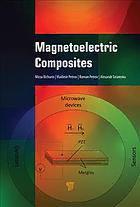
Magnetoelectric composites PDF
Preview Magnetoelectric composites
Magnetoelectric Composites Magnetoelectric Composites Mirza I. Bichurin | Vladimir M. Petrov Roman V. Petrov | Alexander S. Tatarenko Published by Pan Stanford Publishing Pte. Ltd. Penthouse Level, Suntec Tower 3 8 Temasek Boulevard Singapore 038988 Email: [email protected] Web: www.panstanford.com British Library Cataloguing-in-Publication Data A catalogue record for this book is available from the British Library. Magnetoelectric Composites All rights reserved. This book, or parts thereof, may not be reproduced in any form Copyright © 2019 by Pan Stanford Publishing Pte. Ltd. or by any means, electronic or mechanical, including photocopying, recording or any information storage and retrieval system now known or to be invented, without written permission from the publisher. For photocopying of material in this volume, please pay a copying fee through the Copyright Clearance Center, Inc., 222 Rosewood Drive, Danvers, MA 01923, USA. In this case permission to photocopy is not required from the publisher. ISBN 978-981-4800-04-4 (Hardcover) ISBN 978-0-429-48867-2 (eBook) Contents Foreword Preface ix 1. M odeling of Magnetoelectric Composites x1i 1.1 Low-Frequency Range 13 1.1.1 Symmetric Layered Structures 14 1.1.2 Bilayer Structure 18 1.1.3 Examples of Multilayer Structures 19 1.1.4 Bulk Composites 27 1.1.5 Magnetoelectric Effects in Compositionally Graded Layered Structures 32 1.1.6 Magnetoelectric Effect at Zero Bias Field 38 1.1.7 Magnetoelectric Effect in Dimensionally Graded Laminate Composites 44 1.1.8 Maxwell–Wagner Relaxation in ME Composites 54 1.1.8.1 Layered composites 56 1.1.8.2 Bulk composites 62 1.2 Electromechanical Resonance Range 68 1.2.1 Longitudinal and Radial Modes 68 1.2.2 Disc-Shaped Bilayer 73 1.2.3 Bending Modes 78 1.2.4 Shear Vibrations 82 1.3 Ferromagnetic Resonance Range 85 1.3.1 Bilayer Structure 86 1.3.2 Basic Theory: Macroscopic Homogeneous Model 90 1.3.3 Uniaxial Structure 93 1.3.4 Layered Composite with Single-Crystal Components 97 vi Contents 1.3.5 Electric Field–Induced Broadening of Magnetic Resonance Line 101 1.3.6 Resonance Line Shift by Electric Signal with Electromechanical Resonance Frequency 105 1.4 Magnetoacoustic Resonance Range 107 1.4.1 Direct Magnetoelectric Effect 108 1.4.2 Effects of Exchange Interactions on Magnetoacoustic Resonance 111 1.4.3 Electric Field–Induced Magnetic Excitations 115 1.5 Nomograph Method for Predicting Magnetoelectric Coupling 121 1.5.1 Low-Frequency Magnetoelectric Coupling 121 1.5.2 Magnetoelectric Coupling at Bending Mode 128 1.5.3 Magnetoelectric Coupling at Axial Mode 132 1.5.4 Magnetoelectric Coupling in FMR Region 134 2. 1A.p6p licatCioonnsc loufs Mionagsn etoelectric Composites 113591 2.1 ME Inductance 151 2.1.1 Theoretical Model of the Device 152 2.1.2 Comparison of Theoretical and Experimental Data 157 2.2 ME Sensors 160 2.2.1 Magnetic Field Sensor 161 2.2.1.1 Principle of operation 162 2.2.1.2 Equivalent circuit 163 2.2.1.3 Design 165 2.2.1.4 Discussions 168 2.2.2 Current Sensor 170 2.2.2.1 Nonresonant current sensor 171 2.2.2.2 Resonant current sensor 179 2.2.3 Crankshaft Position Sensor 186 Contents vii 2.2.3.1 Principle of operation 187 2.2.3.2 Design 188 2.2.3.3 Discussions 193 2.3 ME Harvesters 194 2.3.1 ME Elements Design 195 2.3.2 Measurement Stand 196 2.3.3 Measurement Data 197 2.3.4 Theoretical Approach 201 2.3.5 Generator 204 2.3.5.1 Design 204 2.3.5.2 Prototype of generator 206 2.3.5.3 Measuring stand 208 2.3.5.4 Characteristics of ME element 209 2.3.5.5 Characteristics of generator 211 2.3.5.6 Configuration of the magnetic field generator 213 2.3.5.7 Calculation of ME coefficient 214 2.3.5.8 Outlook for increasing output power of the ME generator 215 2.4 ME Microwave Resonators 215 2.4.1 ME Microwave Devices 219 2.4.2 Magnetoelectric Band-Pass Filter 220 2.4.2.1 Characteristics 220 2.4.2.2 Filter design 222 2.4.2.3 Results 223 2.4.3 Magnetoelectric Phase Shifter 225 2.4.3.1 Experiment 226 2.4.3.2 Results 228 2.4.4 Magnetoelectric Microwave Isolator- Attenuator 229 2.4.4.1 Results and discussion 231 2.4.5 Modeling of ME Microwave Devices 234 2.4.5.1 Results and discussion 238 2.5 ME Gyrator 241 2.5.1 Gyrator’s Element Design 242 viii Contents 2.5.2 Measurement Data 245 2.6 ME Microwave Antenna Array 247 2.6.1 Modeling and Results 249 2.7 ME Microwave Modules and Radars 258 2.7.1 Basic Element Design 258 2.7.2 Microwave Magnetoelectric Module 262 Index2.8 Conclusions 265 275 Foreword ix Foreword Functional materials are of crucial importance in novel electronic devices. Among functional materials, magnetoelectric multiferroics represent a class of smart materials that transforms one basic physical property into another. Magnetoelectric effect in these materials is a product property of magnetostrictive and piezoelectric components. There are many research papers on the magnetoelectric interaction due to significant technological promises. The fact is that composites have an obvious advantage over single-phase materials, since they demonstrate a giant magnetoelectric response above room temperature and are ready for technological applications. High magnetoelectric coefficients necessary for engineering applications can be achieved by the appropriate choice of components with high magnetostriction and piezoelectricity. In this book, the authors present their many years of experience in the study of magnetoelectric composites and devices. The central issue explored by the authors of this book is bringing together numerous contributions to modeling of ME composites and the creation of prototypes based on them, allowing one to consider magnetoelectric phenomena from a new point of view based on their practical applications. It should be noted that currently large number of works are devoted to the study of the possibility of constructing the magnetoelectric devices, which in a number of parameters should surpass the well-known semiconductors, ferrite and ferroelectric ones. The authors have examined several low-frequency and microwave magnetoelectric Magnetoelectric Composites devices and discussed the observed advantages in this book. The focus of is on the advanced modeling techniques and state-of-the-art experimental methods that are essential to improve the magnetoelectric performance of composites and devices. The book is useful for researchers and
